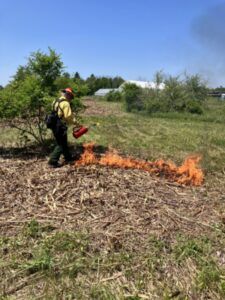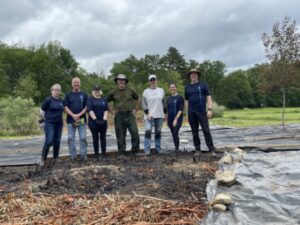(by Parker Schuerman)
Typically, on the first day of June it is not 90°F in Concord, NH. However, under calm, hot conditions on this dry, late spring day, NH Audubon conducted a small, prescribed burn (Rx Fire) at the Silk Farm Wildlife Sanctuary. The goal of this burn was to accomplish five things:

- Remove litter and duff surrounding a patch of invasive Japanese Knotweed.
- “Top-kill” Japanese Knotweed, meaning that the stem and all surface and immediate sub-surface plant would be left dead from the fire. (The Japanese Knotweed at the Silk Farm Sanctuary was growing in the patch after repeatedly being mowed down at end of the growing season in the fall of 2022 and twice this spring – once in April and once in May.)
- Prep the patch for installation of landscape fabric and plastic to attempt to reduce the expansion and control Japanese Knotweed.
- Supplement and enhance mechanical treatments by reducing stem density by the thermal thinning provided by the prescribed burn (heat on target).
- Deprive Japanese Knotweed of nutrients by blocking the sun under landscape fabric and stressing it with seasonal heating conditions.
It may be ambitious to take on this nemesis, and after an 850–900°F backing fire across this patch of knotweed, it was still re-sprouting in places. This is why we call it the Lazarus of invasives, it is one tenacious plant. (There are two other patches that will be mowed biweekly throughout the summer, to weaken the plant. And perhaps if we get the right winds, we’ll put a fire to them, too.)
But speaking of tenacious and determined, that is where this group from Medtronic came in…

Luckily, this group did not experience that 90°F heat. The skies were cloudy with a slight drizzle and a cool western breeze for most of the morning. On June 5, I was helped by Helen, Curt, Jeanette, Beth, Holly, and Jason from Medtronic. This group of determined volunteers rolled out, stapled, and weighed down landscape fabric and plastic to suppress the regrowth of my nemesis. Our friends from Medtronic rolled out about ½ acre of plastic and landscape fabric to help us start the reclamation process and expand our pollinator meadow. Many hands made light work, and this group quickly dispatched and weighed down the barrier with rocks and old beams so that in the future we may be able to enjoy more native wildflowers and grasses. As with most experiments, we need to wait to obtain the best results. It may be one or two years before we even try to re-seed this area and take up the plastic. So, be patient with us as we try to take on Japanese Knotweed and control other invasive species in Concord.
